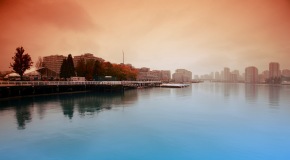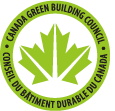Work leading up to this project
In 1991, City Council issued a challenge to create a community that is sustainable: “on the south shore of false creek, develop a neighbourhood that is the model of sustainability, incorporating: forward-thinking infrastructure; strategic energy reduction; high-performance buildings; and high transit access”.
April 2010 - Southeast False Creek height review open house
The public was invited to attend an open house to discuss the proposed maximum heights for buildings in Southeast False Creek (SEFC).
July 2008 - Green building strategy adopted
The City adopted a green building strategy for SEFC, requiring all buildings to meet the LEED (Leadership in Energy and Environmental Design) silver standard.
March 2005 - Bylaw approved by Council
The SEFC official development plan bylaw was approved by Council on 1 March 2005.
2003 - Launch of the official development plan
Council launched the official development plan process to determine parks, rights-ofway, public amenities, overall density, and massing for the area.
History of the area
SEFC has been an industrial area since the late 1800s. Its industrial uses have included sawmills, foundries, shipbuilding, metalworking, salt distribution, warehousing, and the city’s public works yard.
The original shoreline was near 1st Avenue and the land area north of it is comprised of fill from many sources, including Grandview Railway Cut and ash from a former incinerator in the Cambie Yard.
Most of SEFC was first subdivided into streets by Israel Powell in 1888. Powell was one of the chief proponents of British Columbia's 1871 entry into Canada, and he named the streets after the country's provinces, to symbolically represent Canada.
In 1886, the City of Vancouver was established, serving as the western terminus for the Canadia Pacific Railroad across Canada. In the 1890s the city’s residential development first spilled south over False Creek, creating the city’s first suburb, Mount Pleasant, but its shoreline was still not yet built upon.
During the early 1900s, False Creek became lined with sawmills and shingle mills employing 10,000 workers, and Mount Pleasant filled with houses to 1st Avenue.
The Vancouver City Yard relocated to the shore just east of the Cambie Bridge and an incinerator was built there in 1910. Most jobs in these pre-automobile days were in the industrial plants inside the Fairview Beltline streetcar route that circled False Creek.
The war years
During the First World War, the city block at the foot of Columbia Street (the Canron site) was home to Coughlan’s shipyard, where a large contract to build 8,800 ton naval ships made the company Vancouver’s largest employer in 1918. Here 2,000 Vancouverites fought the war on the home front, toiling amidst great noise and smoke to produce the largest tonnage of steel ships in the British Empire.
Following the war, a number of new wood yards and coal yards appeared along the Southeast False Creek shore, while the sawmills and metal working industries thrived.
Despite the Depression, Southeast False Creek was the site of significant new activity in the 1930s. In 1931 the Vancouver Salt Company constructed a new building at the foot of Manitoba Street. Today this building is the only building expected to be retained on all the city-owned land north of First Avenue.
In the Second World War 2,000 steelworkers laboured inside the Canron Building, then known as Western Bridge, fabricating large sections of 10,000 freighters to replace the ships sunk by German U-boats in the North Atlantic. Just outside the building 3,000 shipbuilders working for Westcoast Shipbuilders assembled and launched a total of 55 of these 10,000 ton freighters in just 4 years.
On the site immediately to the east, the Sitka Spruce Lumber Company took prime Queen Charlotte Island spruce and milled it into structural members for WWII aircraft.
In the war years the Industrial Age peaked in Vancouver’s False Creek as 5,000 union workers laboured at the Canron site alone, while thousands of others at over a dozen sawmills cranked out materials for the war effort, and smaller machine shops, foundries and manufacturers of industrial equipment filled the spaces between
In these years women entered the industrial labour force in large numbers for the first time and union membership soared, increasing 10 fold in the forest industry alone. By the 1950s, SEFC was home to the city yard, Dominion Bridge, Western Bridge (later Canron) Steel Fabricating, Sauder Lumber Company, Vancouver Salt Company and Ruskin Cedar Products.
Post-war development
In the 1960s industry began to leave False Creek and not be replaced. In 1970 city council decided to rezone much of False Creek for housing and parks. In the 1980s Expo 86 became the reason to clear all industry from the north shore of False Creek.
Meanwhile, in Southeast False Creek, workers in the Canron Building were fabricating steel for sites all over the world, as well as for downtown Vancouver highrises, the Alex Fraser Bridge, West Edmonton Mall, Canada Place, Seattle’s Husky Stadium, and for the largest free-standing building in the world, the Boeing plant in Everett, Washington.
The industries of Southeast False Creek held on till 1990, when Canron moved out of the Canron Building. This huge historic building was torn down in 1998.The end of the 1990s presents an almost blank slate at Southeast False Creek north of 1st Avenue—a site that soon will be as vacant as it was at the end of the 1890s.
 Southeast False Creek
Southeast False Creek
 LEED certification is an internationally accepted benchmark for the design, construction, and operation of high performance green buildings.
LEED certification is an internationally accepted benchmark for the design, construction, and operation of high performance green buildings.